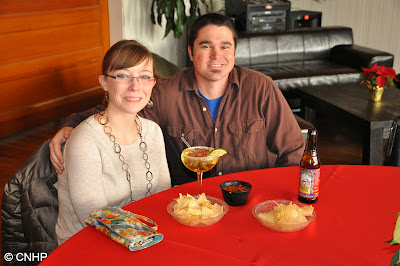I regret to report that unlike two blogs in the past month,
this one does not involve beer, but it does involve margaritas! We held
our annual recognition event at The Rio Grande Mexican Restaurant last
Friday. With some of our partners and colleagues, we honored CNHP’s
volunteers, students, and staff over a delicious buffet lunch in the Agave Room
at the downtown Fort Collins restaurant.
 |
| Revelers in the Agave Room - what a nice venue! |
 |
| Katie Schneburg and Michelle Kamandy - two of CNHP’s amazing work study students |
 |
| Julie White, winner of a CNHP Outstanding
Volunteer Award, and her fiancé |
 |
| Rebecca Hopson, winner of a CNHP Outstanding
Volunteer Award, with Jill Handwerk, Botany Team Leader |
We gave certificates to our current student staff members-
Michelle Kamandy, Nathan Jensen, Jacqui Marquez, Gabe Scott, Katie Schneberg,
and Sally Ebeling.
And our three grand prize winners of the CNHP Photo Contest
were Michael Menefee (landscape), Jeremy Siemers (species), and Pam Smith (people at work).
 |
| Michael Menefee's winning landscape photo of the High Park fire |
We recognized Michelle Fink, Karin Decker, and Gabrielle Smith
for coordinating the wildly successful CNHP Blog.
And last but not least, our kitchen cleaning team, led by
Pam Smith, received the prestigious Green Sponge Award, for improving our
standard of living tremendously here at the CNHP office.
 |
| Winners of the prestigious Green Sponge Award,
led by Pam Smith (with the big green sponge and “scepter”) |
Our distinguished guests included Chris Pague and Rick
Knight, both of whom were instrumental in bringing CNHP to CSU! Heather
Knight, one of CNHP’s first employees and current partner at TNC, came as
well. Ken Wilson, Department Head of FWCB, came along with Val Romero and
Mary Olivas-Lee from our Budget Office. Brad Johnson and Jen Ackerfield,
our colleagues at CSU came also. Brian Sullivan and Eric Odell, two of
our wonderful partners at Colorado Parks and Wildlife joined us along with our
friends at CEMML, Lee Barber and Dave Jones. We even got to catch up with
a couple former employees, Jodie Bell and Jared Papert-Stockton.
 |
| Rick Knight, CSU Professor, Chris Pague, TNC Senior Scientist and former CNHP Director, and Heather Knight, TNC Laramie Foothills Project Director. |
It was a wonderful afternoon, and thank you to all who could
come and be a part of it.














